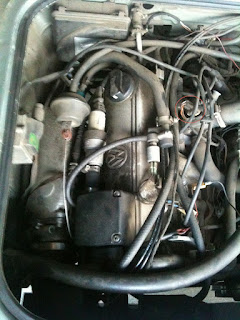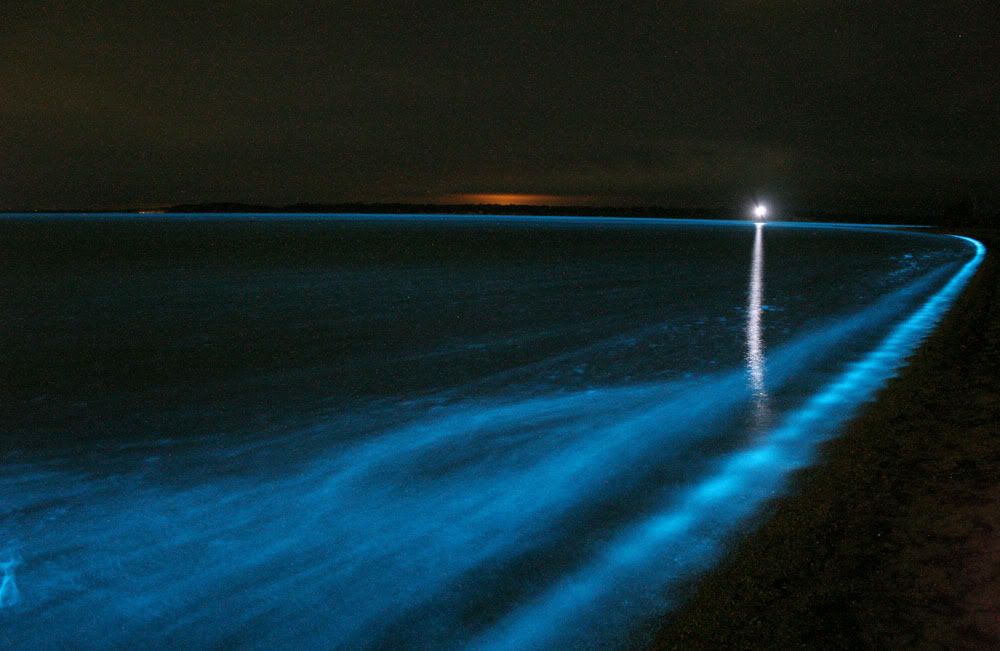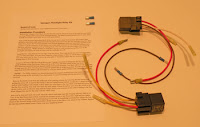And so we have come to the point where we must discuss in depth, our third traveling companion Charles Theodore Finley. Who is Chuck? Well, sit back and let me tell you a story as old as Volkswagens and cable TV in 2006.
The Van
Chuck first and foremost, is a Van; or as the EPA prefers it, a “multi-passenger, multi-purpose vehicle”. A 1982 Volkswagen Vanagon Camper. But beneath his cool white (paint code LD90) exterior, lays a deep dark secret. Chuck is a Shagin-Wagen, a super-funk generating machine descended from the lord of all hippy busses, the ‘62 Spilt-Window Westfalia camper.
 |
| Chuck's Grandfather |
Or at least that’s what this ancient hippy told me in Vegas…
Anyways, He has a few interesting tricks up his sleeves. First he has 2 fold out twin-ish sized beds.
From what I understand these beds can sleep a total of 3 women and 1 man. Again, the Vegas Hippy assured me that the 2-2 and 1-3 combinations were impossible due to van physics, who am I to argue with the master?
Additionally Chuck can pop his top to provide an 8ft ceiling and prodigious ventilation when necessary.
Now, don’t get your mind blown by all this Epicness. There is much more to follow. Chuck has a stove, a fridge, and a sink. That’s right, a whole freaking mini-kitchen.
The stove and fridge are powered by a 3 gallon propane tank mounted under the driver’s side. The sink gets its water from a 12 gallon tank inside the interior cabinetry.
Now, this is all standard equipment for Westfalia camper vans. In addition to all this (admitted already awesomeness) we have outfitted Chuck with a variety of upgrades, and improvements.
Curtains: The previous owner (PO) did some atrocious things to Chuck’s interior. We remedied that with new upholstery (done by Jen) and new thermal curtains (Jen again).
These curtains contain advanced magnetic wizardry that allows them to stick to metal. Black magic you say!? Tis the power of SCIENCE! (you may be a child of the ‘90s, like me, if you just had a flashback to Bill Nye the science guy)
Seats: Chuck’s front seats were adequate, but not really enough for the amount of driving we do. We pulled the stock seats and replaced them with early Eurovan seats. I modified the tracks to fit Chucks frame, Jen re-upholstered them in matching colors and added lumber supports. I also removed the driver’s side swivel as it is totally useless. The passenger swivel works very well for us.
We also added a low-power folding fan. It gimbals in almost every direction, very nice when the weather gets warm, due to Chuck’s lack of AC.
Lighting: Chuck came from the factory (Westfalia Werke) with the cutting edge in lighting (in 1982…) incandescent lights that use tons of electricity. This is not a big deal for a home or office where power is mostly unlimited (not free though); but in the van all our electrical gear is powered by a battery bank (separate from the starter battery, cause a dead starter is bad mojo in the boondocks). This means we are limited on total energy capacity. The AUX battery bank is only changing when we drive, so extended stops can be an issue. Thus we tossed the old incandescent lights for the lighting of the future, LEDs.
We decided to use 12v LED strips, which I cut to length and installed in and under chuck. These lights make 3x the light at half the power usage of the previous ones. Not only are these strips self-adhesive, they are silicone coated for waterproofing as well.
Shower: We needed some way to wash the road grime off without freezing or paying for a shower. Through this need, the power of Google and Amazon, and a 4-year engineering degree; I developed a shower system.
(I'm to lazy to go get a photo of our shower in action, will have to be another day.)
This system uses water from Chuck’s free water tank and pumps it through a heat exchanger that uses hot engine coolant to heat the water. Then after passing through a thermostatic mixing valve (the thing in your shower that keeps a nearby toilet flushing from scalding you) the water exits through a small spray nozzle. This system allows us to take warm showers anytime we have water and a warm engine (usually takes about 3-5 minutes of idling to get the water warm enough). We have a tent-like thingy to cover the rear hatch so we can shower in privacy.
 |
| Stock photo of the Bus Depot Add-A-Room. |
Power: Chuck did not originally come with an AUX battery. Although almost all later model campers did. We could have put an AUX battery in the stock location under the driver’s seat, but the small space severely limits the size and thus the capacity of the battery. Instead of struggling to get a battery under the seat, we opted to install a larger battery bank under the rear bench.
This battery bank consists of 2 GC-2 type golf cart batteries in series. They provide around 200 Amp-hours of reliable capacity. They handle vibration and deep discharges well. The only required maintenance is checking the water. The AUX bank is connected to Chuck’s charging system with a Blue-Seas battery isolator. This nifty little device prevents Chuck’s starting battery from being discharged by only connecting the AUX battery to the charging system when the engine is running.
Exterior: Chuck has had a substantial number of exterior modifications in the name of improved driver happiness.
Chuck has new eyes. We replaced the weak stock bulbs with H4 lenses and high output bulbs rated at 100W high and 55W low beams. This necessitated installing some relays to take the load off the headlight switch in order to prevent crispiness.
Chuck has new ears. The stock mirrors on early vanagons are absolutely worthless. They are manual adjustment and so floppy, that a strong wind can blow them flat.
We replaced them with some late model mirrors.
These little girls are power and heated, oh ya daddy likes it heated… cough cough…. Ummm anyways…
Speaking of mirrors, the stock rear-view mirror is just as worthless due to the low hanging rear cabinet. We replaced Chuck’s with a compass auto-dimming mirror from a Cadillac which is mounted 14 inches lower on the dash. 4$ labor day at the pick-n-pull junkyard
Chuck came to us with some terrible shocks. The rears were replaced with Monroe sens-tracs for a F-150. Worth every penny, and they cured Chuck’s saggy butt. The fronts we replaced with sense-tracs for an SUV, they just don’t have the damping for Chuck’s heavy front end, and they will be replaced at some point.


Engine: Chuck’s heart was originally a 1.6 liter non-turbo diesel. Absolutely gutless in the normal vanagon, in a Westy camper? It was downright dangerous… Chuck came to use with a 1.8 liter gas engine. It was barely adequate, but I wanted and bit more oomph. I pulled the old engine and started the Frankensteining. Since almost all VW inline-4 engines until the late 90s use the same core design, they are mostly interchangeable with each other, at least physically. I pulled parts from 3 different cars in the junkyard and built a hybrid engine. The sport tuners have done this many times before me, and through the power of google I was able to follow in their footsteps. (brace yourself for tech specs in 3…2…1) Chuck now has a 2.0 liter 11.0 compression 8 valve counterflow inline-4. This setup uses a custom exhaust with stock-ish exhaust hangers. The fuel management system is unmodified (mostly) Digifant-2 from a cabriolet. This is all held in place by stock diesel vanagon mounting parts.
 |
| Cabriolet setup that inspired me (and somehow fit). |
 |
| Another Vanagon I4 setup, this inspired me to use digifant. |
The transmission is a stock air-cooled vanagon transmission. It is physically the same as an early diesel transmission but the gear ratios are much better suited to the new engines torque curve and redline. I would like 1st and 4th gear to be a bit lower. Tires are the stock size.
The Myth:
How did Chuck get his name? Well it is a long, but not actually long story. It all starts in 2006, with the television show Burn Notice. (a personal favorite of my wife, back when we had a TV) Within this show there is a character named Sam Axe. Now Sam is a bit of an enigma, ex-special forces, crazy mojito drinking, and Hawaiian shirt wearing retiree. Sam has an alias he uses when he needs to do “business”. This alias is Charles Theodore Finley, or Chuck. The way I see it Charles is an alias within a character, within an actor. Why did we name our home on wheel Chuck? In a way, Chuck (the van) is the same; a home, within a van, within the greater world. The layers are what counts. Or maybe it is because our Chuck is as versatile as the alias of Sam Axe? It could just be because Jen secretly fantasizes about the Sam Axe character? Or maybe it’s because Charles Finely is an excellent 3rd wheel in the show, kind of like our van? We may never know, but always remember Chuck Finely is forever!
The Legend:
Westfalia Campers have been the epitome of micro-scale camping since the ‘60s. Many a baby was conceived in the back of one of these vans during a Grateful Dead concert. I have heard rumors that during the 60s and 70s one of these vans could add 3 points to the apparent hotness of the owner. A Vegas Hippy once told me of a mystic ritual that could only be performed within a Westfalia camper. According to this wizened master; if performed correctly this ancient rite could cause women’s clothing to literally explode off their bodies. 0_0
Steeped in mystery, hung in legend, and nearly impossible to find parts for, the Westfalia Camper has made an irrevocable impression on the American Psyche. Chuck is forever.





.jpg)















